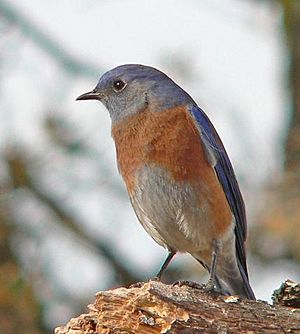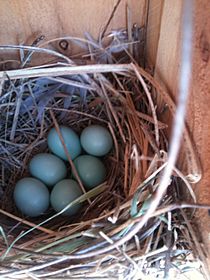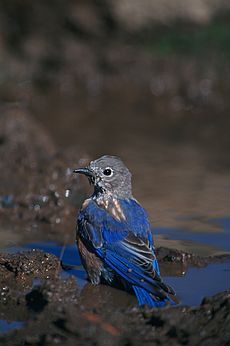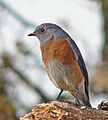Western bluebird facts for kids
Quick facts for kids Western bluebird |
|
|---|---|
 |
|
| Adult male | |
| Conservation status | |
| Scientific classification | |
| Genus: |
Sialia
|
| Species: |
mexicana
|
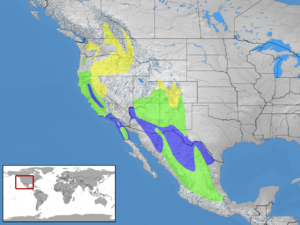 |
|
| Range of S. mexicana Breeding range Year-round range Wintering range | |
The western bluebird (Sialia mexicana) is a small, colorful bird found in North America. It belongs to the thrush family. These birds are known for their bright blue feathers and lovely songs. They live in many different places, from forests to deserts.
Contents
What is a Western Bluebird?
The western bluebird is a small bird, usually about 15 to 18 centimeters (6 to 7 inches) long. It is a bit stocky, meaning it has a solid build.
How to Identify a Western Bluebird
Adult male western bluebirds are easy to spot. They have bright blue feathers on their head, back, and throat. Their chest and sides are a warm orange color. You might also see a brownish patch on their back. Their belly is gray.
Female western bluebirds are a bit less colorful. Their blue feathers are duller, and their throat is gray. Their chest is a dull orange, and their belly is gray. Both male and female western bluebirds have a thin, straight beak and a fairly short tail.
Young western bluebirds, called immatures, have even duller colors than the adults. They also have spots on their chest and back.
Western Bluebird Calls and Songs
Western bluebirds make different sounds. Their mating songs can sound like "cheer," "chur-chur," or "chup." These calls help male bluebirds find females in thick forests. Males also use these calls to tell other males that a certain area is their territory.
How Western Bluebirds Compare to Other Bluebirds
It's easy to tell the western bluebird apart from its relatives.
- The western bluebird has a blue throat (males) or a gray throat (females).
- The eastern bluebird (Sialia sialis) has an orange throat.
- The mountain bluebird (Sialia currucoides) does not have any orange color on its body.
Where Do Western Bluebirds Live?
Western bluebirds live in many parts of North America. They have learned to live in different places, even when their natural homes are changed.
Western Bluebird Habitats
These birds can be found in:
- Coniferous forests (forests with trees like pines)
- Farmlands
- Semi-open areas
- Deserts
Western Bluebird Range
You can find western bluebirds all year long in:
- California
- The southern Rocky Mountains
- Arizona
- New Mexico
- Parts of Mexico, as far south as Oaxaca and Veracruz
In the summer, they also breed further north in places like:
Birds from the northern parts of their range might migrate south for the winter. Birds living in the southern areas often stay in the same place all year.
Western Bluebird Life Cycle and Reproduction
Western bluebirds build their nests in holes or special nest boxes. They often have to compete with other birds for good nesting spots.
Nesting Habits
Western bluebirds cannot dig their own holes for nests because their beaks are too weak. They rely on woodpeckers to make holes for them in trees. They also use nest boxes that people put up.
Sometimes, other birds like tree swallows, house sparrows, and European starlings try to take over their nests. House sparrows might even attack western bluebirds to get their nests. You can help protect bluebirds by making sure nest box openings are small (about 1.5 inches wide). This helps keep larger birds like starlings out.
Protecting Nests
Predators like cats, raccoons, possums, and some birds of prey (like the Cooper's hawk) can be a danger to bluebird nests. Insects like ants, bees, and wasps can also get into nest boxes and harm the young birds.
Eggs and Young Birds
Western bluebirds usually lay 2 to 8 eggs in a clutch. The average egg size is about 20.8 x 16.2 millimeters (0.8 x 0.6 inches). Their eggs are oval-shaped, smooth, and shiny. They are usually pale blue to bluish-white, but sometimes they can be white.
The baby birds, called nestlings, stay in the nest for about 19 to 22 days before they are ready to fly. If it's a good year, parents can raise two groups of babies, called broods. Each brood usually has 4 to 6 eggs.
Sometimes, young western bluebirds whose own nests have failed will help their parents raise a new brood.
What Do Western Bluebirds Eat?
Western bluebirds are good at finding food in different ways.
Hunting for Food
They often perch on a branch and then fly down to the ground to catch insects like worms. They can also catch insects in the air while flying.
Western Bluebird Diet
Their main diet includes:
- Insects
- Berries
They also drink water from nearby streams or from bird baths.
Similar Species
- Eastern bluebird (Sialia sialis)
- Mountain bluebird (Sialia currucoides)
Images for kids
See also
 In Spanish: Azulejo de garganta azul para niños
In Spanish: Azulejo de garganta azul para niños



